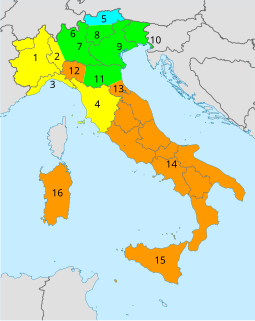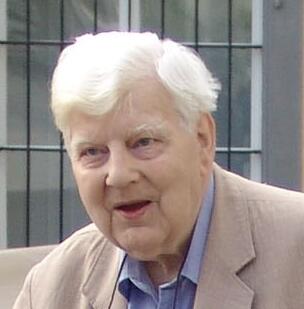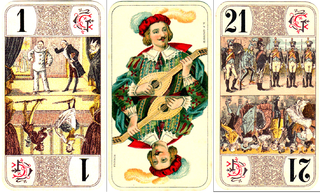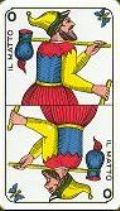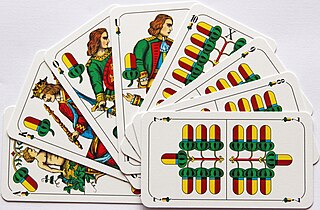| A trick-taking game of the European Tarot card game family. | |
 | |
| Origin | Austria |
|---|---|
| Type | Trick-taking |
| Players | 3 |
| Skills required | Tactics, Strategy |
| Cards | 54 |
| Deck | Industrie und Glück |
| Play | Counter-clockwise |
| Card rank (highest first) | Trumps: Sküs, 21-1 ♣♠ K Q C J 10 9 8 7 ♥♦ K Q C J 1 2 3 4 [1] |
| Playing time | 20 min. |
| Random chance | Moderate |
| Related games | |
| Cego, Königrufen | |
Tapp-Tarock (Viennese Tappen) is a three-player tarot card game which uses the 54-card Industrie und Glück deck. This is an introductory game for more complex tarock games like Cego or Königrufen. During the interwar period, it was the preferred card game of Viennese coffee houses. Even today Tapp-Tarock is played sporadically. The exact date when it appeared is not possible to identify, but it is likely to have been developed in Austria in the early 19th century. [2] The oldest version was narrated in 1821. [3]

Industrie und Glück is a pattern of French suited playing cards used to play tarock. The name originates from an inscription found on the second trump card. This deck was developed during the nineteenth century in the Austro-Hungarian Empire. The earliest known examples were made in Vienna in 1815. After the collapse of the empire in World War I, it remained the most widely used tarot deck in Central Europe and can be found throughout the former parts of the empire. Though not designed for cartomancy, these cards were used in Argentine fortune telling decks in the mid-20th century.

Cego or Baden Tarock, also called Ceco, is a tarot card game played mainly in Baden, the Black Forest, the adjacent Baar lowland and around Lake Constance in Switzerland and Austria. The game is similar to Königrufen and Tapp-Tarock. It is distinguished by a large skat, or talon, called "the Blind".

Königrufen or Königsrufen is a four-player, trick-taking card game of the tarot family, played in Austria and Southern Tyrol. As with other regional tarot card games, it is usually called Tarock by its players. It is the only variant of Tarock that is played over most of Austria and, in 2001, was the most popular card game in Austria after Schnapsen and Rommé. By 2015, it had become "the favourite card game of Austrians". It has been described as the most interesting tarot game for four players, the 'Game of Kings', a game that requires intelligence and, with 22 trumps in play, as good 'training for the brain'.
Contents
- History
- Cards
- Rules
- Preliminary round
- Dealing
- Bidding
- Contracts
- Game Play
- Variations
- References
- External links
Tapp is a term for the undealt cards in the middle of the table called the talon in other tarock games or stock, widow, kitty, or skat in other card games. Tappu or Tappä is another name for the Swiss tarot game of Troggu and the Stubaital game of Bauerntarock.
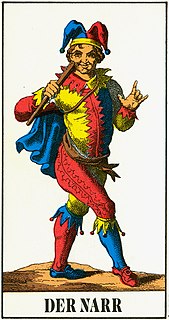
Troggu is a member of the tarot family of card games. Synonyms for the games name are: Trogga, Tappu and Tappä. It is played in the area of Visp, Switzerland, in Upper Wallis, especially in St. Niklaus and Grächen. After Troccas, it is the second most played tarot card game in Switzerland.

The Stubaital is an alpine valley in Tyrol, Austria. It is the central valley of the Stubai Alps. The river Ruetz flows through the valley.

Bauerntarock also called Brixentaler Bauerntarock, is a point-trick card game played in the Brixental, Austria. It may have originated in the 19th century as an adaptation of the 54-card Tapp Tarock game onto the cheaper and smaller 36-card German deck. Another possibility is that it was adapted from the 78-card Tarok-Ombre game as the ratio of trumps to non-trumps is almost the same. It uses the Skat Schedule found in popular regional games such as Jass and Schafkopf. It is closely related to Bavarian Tarock, Württemberg Tarock, and especially Dobbm. Like Bavarian Tarock and Tapp, Brixental Bauerntarock and Dobbm do not belong to the true tarot games, but have adopted rules from Tapp Tarock. The most fundamental difference between these games and true tarot games is in the use of German or French decks instead of true Tarot playing cards.
